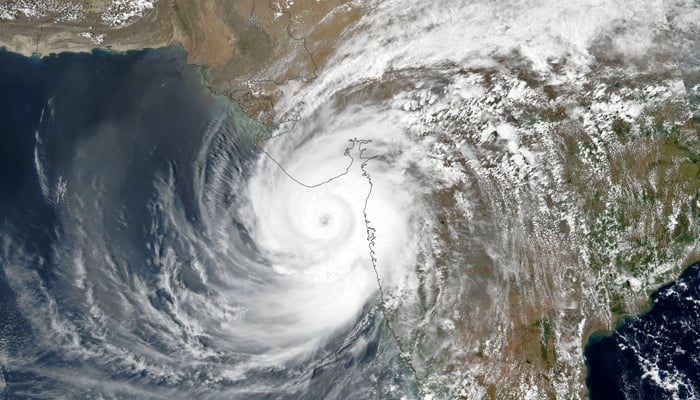Timeline: 130-year history of cyclones ravaging Pakistan
Cyclone Yemyin was Pakistan's third deadliest cyclone in history, as it affected the lives of 2 million people
June 14, 2023

LAHORE: Archival research uncovering Pakistan's cyclone history traces back to July 10, 1894, when Sindh endured a typhoon, while a devastating hurricane struck Balochistan's Makran Coast in the subsequent year. These findings shed light on the cyclonic impact in regions post the 1947 partition.
Despite being rare in the Arabian Sea, which is part of the north Indian Ocean, cyclones tend to veer towards western India rather than causing significant damage along Pakistan's 1,046-kilometre coastline on the Arabian Sea.
The word "cyclone", according to weather websites, is of Greek origin and means a “coil of snake.”
We all know that ferocious cyclones resemble the coil of a snake and possess the venom of thousands of snakes when it comes to their killing capability.
Here follows the timeline and chronology in this context:
According to the Pakistan Meteorological Department (PMD), cyclones hit Pakistan in Balochistan in May 1901, Karachi in May 1902, June 1906, and June 1907. Meanwhile, the September 1926 storm had moved from Indian Gujarat into Pakistan.
There was a cyclone in June and July 1936, while in July 1944, some 10,000 people were left homeless in Karachi. One cyclone in June 1948 impacted the region. In June 1964, Tharparkar and Hyderabad were affected by a hurricane that killed 450 people and left some 400,000 people homeless.
During a cyclone in Karachi on 15 December 1965, the damage was estimated at $4.1 million and claimed about 10,000 lives. The 1970 East-Pakistan cyclone left half a million inhabitants dead. The May 1985 cyclonic storm was moving towards Karachi but had weakened over the sea while still a few 100 kilometers away from Pakistan’s port city.
The November 1993 hurricane had dissipated near the Sindh-Gujarat border. However, it caused massive rainfall and flooding in Karachi. Archives reveal Karachi, Thatta, Keti Bandar, and Badin districts were the worst affected as the cyclone had killed 609 people and displaced some 200,000 humans.
The June 1998 hurricane struck Gujarat in India, while the cyclone electrocuted 12 people in Pakistan. In May 1999, a storm struck Keti Bandar shores, killing 6,200 people.
At least $1 million in relief funds were allocated to cope with the calamity’s damage and aftermath. The cities of Thatta, Umer Kot, Mirpur, Badin, Hyderabad, and Tharparkar were the worst hit.
In May 2001, more than 100,000 people were evacuated from southeastern Pakistan due to the threat of a powerful typhoon in the Arabian Sea. Cyclone Onil in October 2004, which was the first named storm in the Indian Ocean, brought heavy rainfall and gusty winds, leading to nine deaths in Karachi.
Flooded streets and power outages had contributed to at least two electrocution deaths. In June 2007, cyclone Gonu brought heavy rainfall and strong winds to the city of Gwadar. Damage was caused to dozens of boats and school buildings in the area. This storm had claimed 100 lives in Oman, Iran, and the United Arab Emirates and was responsible for $4 billion in damage.
Cyclone Yemyin killed 200 people in Karachi alone on June 24, 2007. According to BBC News, torrential rains and gale-force winds killed more than 200 people in Karachi, which received 17.7mm of rain. This storm made landfall near the towns of Ormara and Pasni in Balochistan, killing 300 more people. Overall, it killed 730 people and affected the lives of 2 million people in Pakistan, making it the third deadliest cyclone in the history of the country.
In November 2009, cyclone Phyan caused gusty winds along the shores of Karachi. In June 2010, Cyclone Phet led to 370mm rain in Gwadar alone and damaged 10,000 houses. This storm had killed at least 18 people in Pakistan — 11 by electrocution and seven due to collapsed walls. Damage was estimated at US$80 million.
In May 2021, a typhoon had killed four people in Karachi, while the September 2021 cyclone named Shaheen had produced gusty winds and rainfall in Karachi, causing one death in Orangi.











